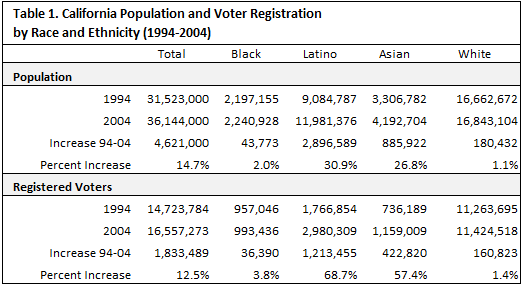In the next few days, Democratic Congresswoman Loretta Sanchez is likely to announce her candidacy for the U.S. Senate seat being vacated by Barbara Boxer. This will widely be seen as a positive development by Latinos who are eager to bolster their political power. Indeed, the political ascension of Loretta Sanchez parallels the rise of the Latino electorate in California.
Loretta Sanchez jolted the Republican Party in California in 1996 when she defeated GOP incumbent Bob Dornan. The significance of her victory is rooted in the district she represents: the 46th Congressional District in Orange County is one of the most conservative in the state. How did Sanchez, a Latina Democrat, defeat a Republican incumbent in the OC? Her victory was the result of demographic shifts, a growing Latino electorate, and anti-immigrant rhetoric and policies that mobilized Latino voters in the Golden State. These factors are considered critical for turning California into a solidly blue state.
First we consider the demographic and political growth of Latinos. Table 1 reports population growth and voter registration growth in the state from 1994 to 2004, broken down by racial and ethnic group. While overall the state grew by nearly 15% (or 4.6 million people), it was almost entirely driven by Latino and Asian American growth. During this period the Latino population grew by 30.9% and the Asian American population grew by 26.8%. The non-Hispanic White population grew by a mere 1.1%. What is most striking about the table is the growth of the Latino and Asian American electorate from 1994 to 2004. During this period the Latino electorate grew by 68.7% and the Asian American electorate grew by 57.4%. Although non-Hispanic Whites are a sizeable electorate, their share over this period has declined significantly.
Demographic shifts are important, but they alone do not explain why Loretta Sanchez was able to defeat Bob Dornan. Turning out Latino voters was critical for her victory, and a key factor that contributed to their political mobilization was the presence in the mid-1990s of controversial ballot initiatives beginning with Proposition 187 (1994), which denied public services to undocumented immigrants and required state employees to report suspected persons who were without documentation. Many Latinos considered Prop 187, 209, and 227 along with the GOP rhetoric backing these initiatives as anti-immigrant and anti-Latino. Given this social context, it is not surprising that Sanchez was propelled to victory in 1996 by Latinos who used the ballot as a means to defeat anti-immigrant initiatives and candidates.
Figure 1 illustrates the rapid rise of the Latino electorate in California from 1980 to 2012. Clearly, Latino voter registration has increased sharply during this period, despite the fact that California is one of the most under-mobilized states in the union. Again, the presence of controversial propositions and the anti-immigrant rhetoric that accompanied those initiatives played a key role in expanding the Latino electorate. Additionally, these factors led Latinos to turn away from the GOP and vote Democratic. It was in this context that a record number of Latino Democrats were elected to various offices throughout the state. Loretta Sanchez was a beneficiary of the Latino backlash toward the GOP. In less than a decade, Latinos in the state went from being politically irrelevant to being a political powerhouse.
Loretta Sanchez’s election in 1996 was part of a larger trend in California in which Latinos began to flex their political muscle. Latino political power is surging ahead with no signs of waning. However, the 2016 Senate election will present Sanchez with some challenges. Despite the fact that Latinos are 39% of the state population, and 67% of her district, the active Latino electorate is considerably smaller.
According to a recent Public Policy Institute of California survey, about two-thirds of likely California voters are non-Hispanic White; 17% are Latino; 11% are Asian Americans and 6% are African American. The survey was taken in a non-presidential election year, and in 2016 Latino voters will constitute a larger share, especially if Loretta Sanchez is on the California ballot.
Despite these challenges, her non-Latino opponents will face a more daunting task: winning a statewide election without significant Latino support. While political scientists are notorious for their inaccurate political forecasts, one thing is certain in 2016 and beyond – Latino voters and Latino elected officials will continue to make significant gains in California and beyond. A Sanchez victory would mark an important milestone in that political momentum.
Adrian Pantoja, Ph.D. is a Senior Analyst for Latino Decisions and Professor of Political Studies and Chicano Studies at Pitzer College, a member of the Claremont Colleges.



